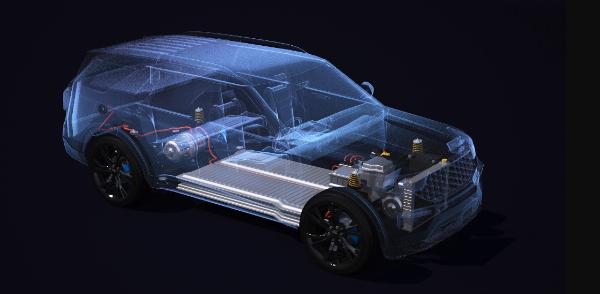Passenger Car Battery Market Growth Forecast: USD 12.5B Size, Trends

Strong 8k brings an ultra-HD IPTV experience to your living room and your pocket.
The global passenger car battery market is anticipated to witness significant growth in the coming years. According to TechSci Research, Passenger Car Battery Market – Global Industry Size, Share, Trends, Competition Forecast & Opportunities, 2028”, the Global Passenger Car Battery Market stood at USD 12.5 billion in 2022 and is anticipated to grow with a CAGR of 6.6% in the forecast period, 2024-2028. This growth is primarily fueled by the aforementioned factors, including the rising demand for EVs and HEVs, stringent government regulations, and continuous advancements in battery technology. The increasing focus on sustainability and environmental concerns is expected to further propel market growth as consumers become more environmentally conscious and governments prioritize cleaner transportation solutions.
The global passenger car battery market is undergoing a revolution fueled by the surging popularity of electric vehicles (EVs) and hybrid electric vehicles (HEVs). Stringent emissions regulations and rapid advancements in battery technology are further accelerating this transformation. This report delves into the key drivers propelling this market forward, analyzes regional trends, and identifies prominent players shaping the industry.
Market Drivers
-
Shift Towards Electric and Hybrid Vehicles: Consumer environmental consciousness is on the rise, leading to a strong preference for cleaner and more fuel-efficient alternatives. This has resulted in a significant surge in EV and HEV sales globally. As a consequence, the demand for advanced passenger car batteries with higher capacities and longer lifespans is growing exponentially. Lithium-ion batteries have emerged as the dominant technology due to their superior energy density and are the preferred choice for powering these vehicles.
-
Stringent Emissions Regulations: Governments worldwide are implementing stricter emission standards to combat air pollution and mitigate climate change. These regulations are pushing automakers to develop electric and hybrid vehicles with lower emissions profiles. To meet these ever-tightening standards, automakers are investing heavily in research and development of battery technology, striving to achieve the range and performance required for electric vehicles to compete effectively with conventional gasoline-powered cars.
-
Advancements in Battery Technology: Continuous improvements in battery technology are a game-changer for the passenger car battery market. Battery manufacturers are relentlessly innovating to enhance energy density, allowing EVs to travel farther on a single charge. Faster charging speeds are another area of active development, significantly reducing charging times and addressing a major consumer concern – range anxiety. Additionally, advancements like solid-state batteries hold immense promise for the future, offering the potential for even higher energy storage capacity and even quicker charging times. These breakthroughs are essential for making electric vehicles a more compelling choice for a broader range of consumers.
-
Government Incentives and Subsidies: Many countries are actively promoting EV adoption through a variety of government incentives and subsidies. These include tax breaks, purchase rebates, and access to carpool lanes for electric vehicle owners. By reducing the initial purchase price and lowering the overall cost of ownership, these incentives make electric vehicles more accessible to a wider audience and accelerate market growth.
-
Expanding Charging Infrastructure: The limited availability of charging stations has historically been a major hurdle for widespread EV adoption. However, the rapid development of fast-charging networks and home charging solutions is addressing this challenge head-on. The growth of these charging infrastructure options is making electric vehicles a more practical choice for daily use, dispelling concerns about running out of power on long journeys. This infrastructure expansion is crucial for bolstering consumer confidence in electric vehicles and further driving market growth.
Browse over XX market data Figures spread through XX Pages and an in-depth TOC on "Global Passenger Car Battery Market.” @ https://www.techsciresearch.com/report/passenger-car-battery-market/16499.html
Market Impact by Region
-
North America: A significant region in the global passenger car battery market, driven by stringent emissions regulations and government incentives. The United States and Canada are witnessing a surge in EV and HEV sales, prompting American automakers to invest heavily in electric vehicle production. To meet the growing demand for batteries, battery manufacturing facilities are expanding across the region. Additionally, North America has seen the rapid development of electric vehicle charging infrastructure, making electric vehicles a more viable option for consumers.
-
Europe: Europe is a prominent region at the forefront of passenger car battery market growth. Several European countries, including Germany, France, and the United Kingdom, boast robust EV markets fueled by ambitious emissions reduction targets and strong government support for electric vehicles. European Union regulations are a major driver, pushing European automakers to actively transition towards electric and hybrid vehicles, consequently driving demand for advanced passenger car batteries. Moreover, Europe is heavily investing in expanding charging infrastructure to support the anticipated growth of electric vehicles in the region.
-
Asia-Pacific: The Asia-Pacific region, particularly China, is a global leader in the passenger car battery market. China's position as the world's largest electric vehicle market is primarily driven by generous government incentives, a vast urban population with growing demand for personal transportation, and a thriving domestic electric vehicle industry. Chinese battery manufacturers like CATL are dominating the global supply chain, producing a significant portion of the world's lithium-ion batteries. Japan and South Korea are also major players in the region, with companies like Panasonic and LG Chem leading the charge in battery technology innovation.
-
Middle East and Africa: The Middle East and Africa are emerging markets in the passenger car battery segment. While electric vehicle adoption is still relatively low compared to other regions, there is a growing interest in electric mobility due to rising fuel costs and environmental concerns. Some Middle Eastern countries, such as the United Arab Emirates, are taking proactive steps to encourage EV adoption by investing in electric vehicle infrastructure and offering attractive incentives. In Africa, rapid urbanization and a growing middle class are creating a potential market for electric vehicles. As these trends continue, the demand for passenger car batteries is expected to rise in the region.
- Latin America:
Latin America is gradually entering the electric vehicle landscape, presenting a market with significant growth potential. Countries like Brazil, Mexico, and Chile are witnessing increasing EV adoption driven by government policies and incentives. These incentives often focus on reducing import duties on electric vehicles and offering tax breaks for EV purchases. However, the market remains relatively smaller compared to more established regions like North America and Europe. Infrastructure limitations and higher upfront costs of electric vehicles compared to gasoline-powered cars are currently hindering widespread adoption. Nevertheless, as consumer awareness of the environmental and economic benefits of electric vehicles grows, and charging infrastructure expands, the Latin American passenger car battery market is expected to experience steady growth in the coming years.
Challenges and Opportunities
Despite the promising outlook, the global passenger car battery market also faces certain challenges. Here's a closer look at both the hurdles and the potential opportunities:
-
Challenges:
- Raw Material Costs: Lithium and other critical battery materials are susceptible to price fluctuations, impacting battery production costs.
- Recycling Limitations: Developing efficient and cost-effective battery recycling methods is crucial for environmental sustainability and responsible resource management.
- Thermal Management Issues: Battery performance and safety are significantly influenced by thermal management systems. Developing innovative solutions to ensure optimal battery temperatures during operation and charging is a key challenge.
-
Opportunities:
- Technological Advancements: Breakthroughs in battery technology, such as the development of solid-state batteries, have the potential to revolutionize the passenger car battery market by offering extended range, faster charging times, and improved safety.
- Second-Life Battery Applications: Utilizing used batteries for applications with lower power requirements, such as stationary energy storage, can extend their lifespan and create a more sustainable battery ecosystem.
- Expanding Charging Infrastructure in Developing Regions: Investing in charging infrastructure in developing regions like Latin America and Africa will be crucial for facilitating wider EV adoption and unlocking new market opportunities for passenger car batteries.
Company Profiles
Several prominent players are shaping the global passenger car battery market. Here's a brief overview of some key companies:
- Panasonic Corporation: A leading Japanese multinational conglomerate, Panasonic is a major player in the lithium-ion battery market. They have established strategic partnerships with leading automakers to supply batteries for electric vehicles.
- Contemporary Amperex Technology Co. Limited (CATL): A Chinese battery technology giant, CATL is the world's largest lithium-ion battery manufacturer by volume. They are a key supplier to major Chinese automakers and are actively expanding their global footprint.
- LG Chem: A South Korean multinational chemical company, LG Chem is a major player in the lithium-ion battery market with a strong focus on research and development. They are known for their innovative battery technologies and are actively supplying batteries for electric vehicles.
- Bosch Group: A leading German multinational engineering and technology company, Bosch is a diversified player in the automotive industry. They are actively developing and supplying battery management systems and other critical components for electric vehicles.
Download Free Sample Report @ https://www.techsciresearch.com/sample-report.aspx?cid=16499
Customers can also request 10% free customization on this report.
Future Trends
The future of the global passenger car battery market is brimming with exciting possibilities. Here are some key trends to watch:
- Integration of Artificial Intelligence (AI): AI-powered battery management systems have the potential to optimize battery performance, extend lifespan, and improve safety.
- Next-Generation Battery Chemistries: Research into alternative battery chemistries beyond lithium-ion holds promise for even higher energy densities and faster charging times.
- Autonomous Electric Vehicles: The rise of autonomous electric vehicles will create new demand for advanced batteries with specific requirements for reliability and safety.
By staying abreast of these trends and capitalizing on emerging opportunities, companies in the passenger car battery market can position themselves for continued success in this dynamic and rapidly evolving landscape.
Conclusion
The global passenger car battery market is on a transformative journey, driven by the surging popularity of electric and hybrid vehicles, stringent emission regulations, and continuous advancements in battery technology. As the market progresses, stakeholders who can adapt to evolving consumer preferences, navigate the challenges, and capitalize on the opportunities will be well-positioned to thrive in this exciting new era of sustainable transportation.
You may also read:
Automotive Fuse Market Worth USD 27 Billion: Growth Forecast
Automotive Glass Market Trends: USD 21 Billion Worth and Growth Outlook
Automotive Ignition System Market Worth USD 7.4 Billion: Size, Share, and Future Projections
CNG & LPG Vehicle Market Size and Trends: Overview of Growth
Automotive Supercharger Market Insights: Forecasting USD 7.7 Billion Revenue
Table of Content-Passenger Car Battery Market
- Introduction
1.1. Market Overview
1.2. Key Highlights of the Report
1.3. Market Coverage
1.4. Market Segments Covered
1.5. Research Tenure Considered
- Research Methodology
2.1. Objective of theStudy
2.2. Baseline Methodology
2.3. Key Industry Partners
2.4. Major Association and Secondary Sources
2.5. Forecasting Methodology
2.6. Data Triangulation & Validation
2.7. Assumptions and Limitations
- Executive Summary
3.1. Market Overview
3.2. Market Forecast
3.3. Key Regions
3.4. Key Segments
- Impact of COVID-19 on Global Passenger Car Battery Market
- Global Passenger Car Battery Market Outlook
5.1. Market Size & Forecast
5.1.1. By Volume & Value
5.2. Market Share & Forecast
5.2.1. By Vehicle Type (SUV, MUV, Sedan, Hatchback, Others)
5.2.2. By Battery Type (Lead Acid, Lithium-Ion, and Other)
5.2.3. By Drive Type (IC Engines and Electric Vehicles)
5.2.4. By Regional Market Share Analysis
5.2.4.1. Asia-Pacific Market Share Analysis
5.2.4.2. Europe & CIS Market Share Analysis
5.2.4.3. North America Market Share Analysis
5.2.4.4. South America Market Share Analysis
5.2.4.5. Middle East & Africa Market Share Analysis
5.2.5. By Company Market Share Analysis (Top 5 Companies, Others - By Value, 2022)
5.3. Global Passenger Car Battery Market Mapping & Opportunity Assessment
5.3.1. By Vehicle Type Market Mapping & Opportunity Assessment
5.3.2. By Battery Type Market Mapping & Opportunity Assessment
5.3.3. By Drive Type Market Mapping & Opportunity Assessment
5.3.4. By Regional Market Mapping & Opportunity Assessment
- Asia-Pacific Passenger Car Battery Market Outlook
6.1. Market Size & Forecast
6.1.1. By Volume & Value
6.2. Market Share & Forecast
6.2.1. By Vehicle Type Market Share Analysis
6.2.2. By Battery Type Market Share Analysis
6.2.3. By Drive Type Market Share Analysis
6.2.4. By Country Market Share Analysis
6.2.4.1. China Market Share Analysis
6.2.4.2. India Market Share Analysis
6.2.4.3. Japan Market Share Analysis
6.2.4.4. Indonesia Market Share Analysis
6.2.4.5. Thailand Market Share Analysis
6.2.4.6. South Korea Market Share Analysis
6.2.4.7. Australia Market Share Analysis
6.2.4.8. Rest of Asia-Pacific Market Share Analysis
Note: IndiBlogHub features both user-submitted and editorial content. We do not verify third-party contributions. Read our Disclaimer and Privacy Policyfor details.







